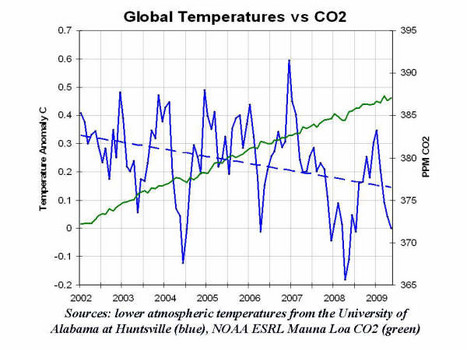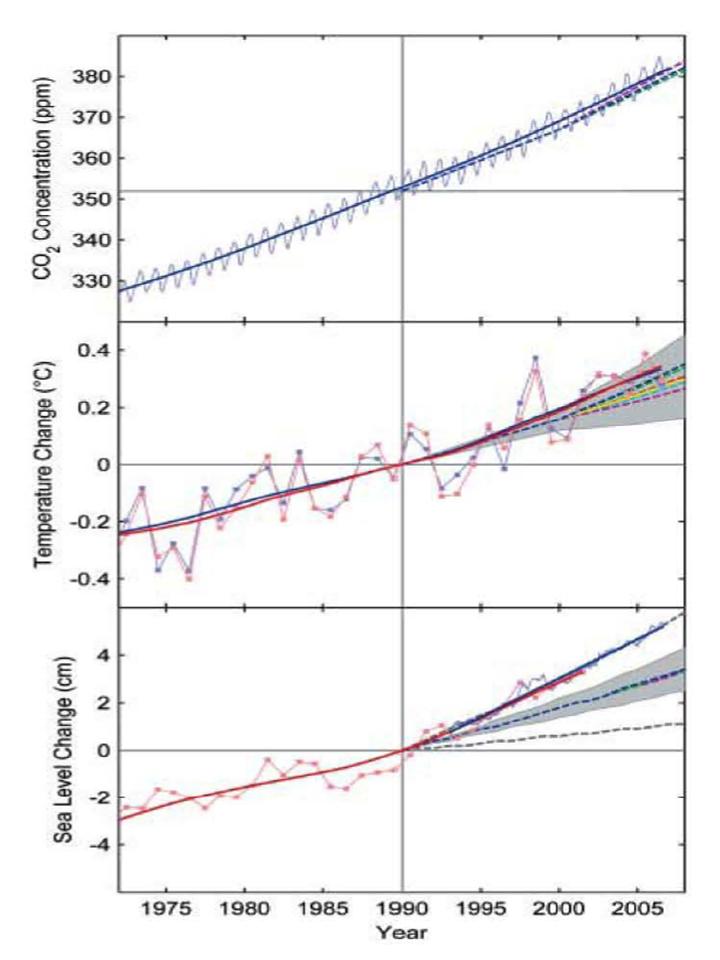Like many people we spent the past couple days digging out from the massive snowstorm that swept across a large swath of the country. This was definitely a made-for-TV-weather event as national and local TV weatherfolks took up their positions and gave us breathless live-remotes of the “Blizzard of 2011”.

40 mph wind + 1 little crack = a barn full of snow.
Almost as predictable as video footage of snow-ploughs on the streets and locals snow-blowing sidewalks; climate change skeptics are using the recent round of winter weather as proof that global warming is a hoax and that there’s really nothing to worry about except the economics of ‘cap and trade’. Just google “climate change skeptics blizzard” and you’ll get the idea.

Bob and Quincy were unfazed by the sub-zero wind-chills.
The problem, of course, is that climate patterns don’t move in a strictly linear trajectory and looking at one extreme event doesn’t prove anything one way or the other. Even looking a few years time sequence may not present the full picture. Deroy Murdock used the illustration below to argue in the National Review Online that there is no link between rising CO2 and increasing temperatures.

But looking at a broader timescale tells a different story. While there are year to year fluctuations a clearer association between rising CO2 and global temperature begins to emerge.

The figure above was taken from an article by Stamhoff et al. 2007, “Recent Climate Observations Compared to Projections” (Science 316 (4): 709). The dashed lines represent the ranges predicted by a major climate model starting in 1990 – the solid line represents what actually happened. As shown in the figure, climate models have been fairly accurate overall and, if anything, have been conservative in predicting climate change; especially with regard to changes in sea level.
So where am I going with this? There are certainly enough climate change debate/Al Gore bashing blogs out there to go around and I don’t want to devolve entirely into that debate, but the simplistic ‘exception proves the rule’ mentality of the skeptics gets a little tiresome. I remember hearing my first talk on global warming at a forest biology conference in the mid-1980’s. The main point that stuck with me then was that increasing global CO2 would not necessarily result in warming every year but that we would see an increase in the frequency and severity of extreme climatic events; droughts, hurricanes, floods, and yes, even blizzards. Even some of the earliest discussions on climate change in the early 1980’s (e.g., Manabe and Stoufer 1980) recognized complex feedbacks in the global climate system that would result in some regions getting wetter while others suffered drought. So while the skeptics may use this weeks’ blizzard as evidence against climate change, increasing frequency of severe weather actually argues for it.
A few other climate facts to ponder:
-Global CO2 is increasing and continues to increase (see top panel in figure above).
– Globally, 12 of the 13 warmest years on record have occurred since 1995.
-Intensity of hurricanes and cyclones is increasing (Webster et al., 2005). While Fox and Friends were happily using the Blizzard of 2011 to debunk climate change; did they notice the most powerful cyclone on record was slamming into Australia?
-Frequency and severity of droughts is increasing worldwide (Burke and Brown, 2006).
-Glaciers are disappearing. If you want to go to Glacier National Park and actually see a glacier, you need to hurry. In 1850 there were 150 glaciers in the park. Today there are 25 and they will likely be gone in 10 years.
The way it was explained to me is warmer air holds more moisture and to expect bigger rain and snow events than in the past.
Bert, I think Bob and Quincy look pretty skeptical there, with their snow-covered shnozzles.
Logical discourse is not what this debate is about.
Class warfare in the U.S. has always been between the more educated and the less educated- not the rich versus the poor.
It is inflamed by economic interests as a divide and conquer strategy that has been consistently affective.
Coal and oil consumption will continue to raise CO2 levels and the theories of climatologists will be tested and even if proven correct will still be denied.
Jan:
That’s certainly part of it. Plus as ocean and surface water temps rice, there is more evaporation to form clouds. But there are also feedbacks in the system. For example, more clouds increases the earth’s albedo reducing some of the light energy reaching the lower atmosphere. Just one example of why these climate model are so complicated and subject to debate.
Alan:
Can’t deny a lot of folks have a vested interest in keeping the status quo. I’m old enough to remember the oil embargoes of ’73 and ’79. You’d have thought that would have sent the message, yet we still import more oil now than we did then.
I thought this was a plant blog.
The science of climate and weather is very contradictory. For every study one does, 2 more may find completely different findings. It’s a science we know very little about when compared to other sciences. The problem is it’s very politically driven. Personally, I don’t believe storms have been getting stronger or more numerous, but our ability to detect and observe them has greatly increased. We only have limited weather data of the past to look at, so to say 12 to 13 of the warmest years on record occurred since 1995, it’s only when compared to the data we have, which is small compared to the period man has been on the planet. The problem with temperature data in the 90s and since is what you are provided with is actual surface observations. Most of these obs are from areas near human development. There’s no surprise that the areas showing the greatest warming are urban areas. NYC is much warmer now than it has been in the past, and the data clearly shows the average temperature increasing year after year. However, if you were to look at Albany, not that far away in the scheme of things, temp data shows periods of 20-30 years of warmer temperatures and cooler temperatures. Many places like Albany are no warmer than they were 50 years ago and some are cooler. Of the four methods of temperature observation, satellites, balloons, paleoclimatology, and surface, only surface has shown any consistent warming.
What I think a lot in the CC/AGW debate fail to consider is the sun’s impact on the climate. It’s already been proven that increased solar activity warms the planet, but not directly. Water vapor in order to form clouds, needs a nuclei onto which it can condense. In the middle and upper layers of the atmosphere, much of these nuclei are provided from space. When there’s a strong solar wind, it keeps these nuclei from penetrating the earth’s atmosphere. When there is less condensation nuclei, you have less clouds, meaning more solar radiation reaches the earth’s surface. Personally, I believe space and solar weather will help us understand our climate better.
Ed, weather is a very important issue to those of us who select and manage plants- especially long lived ones like trees.
Why do so many people think they can accurately asses climate data without any technical background? When these people fear they might have cancer do they go to a specialist or do they ask their car mechanic for an opinion? Of course scientists are often wrong as data can be misleading and the models are always theoretical, but if you want the best odds of an accurate diagnosis you go to a specialist. Climatologists are very close to a unanimous consensus on human activity being responsible for a very dramatic escalation in global temperatures.
I believe one reason for the skepticism over global warming comes from the “coming ice age” hype that was so popular in the 1970s. Then the discussion (a polite word for it) among scientists and media types changed from global cooling to global warming and the general populace became doubtful of it all. And then there is the pesticide that yesterday was safe to use and today is banned because it’s so dangerous. It’s no wonder people don’t trust science.
There is no doubt the climate of the earth is changing, the loss of glaciers being one of the most dramatic pieces of evidence. But most people only hear what they want to hear until the evidence smacks them in the face and they generally don’t see the glaciers or hear much about their disappearance. The debate about the causes of the change will go on practically forever. Self-serving groups will hype one cause over another until doomsday. Let’s just hope doomsday is so far into the future that it won’t matter to us at all.
In the meantime, working to reduce the touted causes of global warming surely won’t hurt the planet and just might help. Paying attention to which trees are in trouble in certain areas may help save some of them from extinction if global weather patterns continue in the current direction. Although evil deeds and controversy make the headlines, man is generally a well-intentioned creature. Knowledge is expanding exponentially. Put those two together and it equals hope.
The reason most of us are aware of the much less ballyhooed theory about global cooling in the ’70’s is due to the efforts of the warming deniers IMO. I had a friend who falls in this category e-mail me an article in Newsweek from the ’70’s on the subject and the scientists quoted were really rather cautious in their assessment of the more limited data (compared to current data) at the time.
The reason surface temperatures appear to be rising is that many of the weather stations reporting cooler temperatures have been quietly removed, and only the stations where warmer temperatures are encountered have been left. Of course this will skew the data to the warmer temperatures, since the cooler reporting stations have been eliminated. But the “climatologists” prefer not to mention this fact.
@ Don: Like the leaked emails mentioned? It was also rumored that some AWOS (Automatic Weather Observation Station) stations had thermometers that were “miscalibrated”. I also find it strange that NASA refuses to release it’s own temperature data that is supposed to be released per the Freedom of Information Act.
As fo
r global cooling, much of it was hysteria back then, but there was legit concern, especially in Europe. In fact, many scientists across northern Europe and into Russia are concerned that a global warming for us means global cooling for them in that ice melt from high latitudes and Greenland cools the Gulf Stream.
I mentioned solar weather above. Here’s a link that shows the current state of things and where we have been and where we may be going. http://wattsupwiththat.com/2011/01/18/nasa-sunspot-number-predictions-revised-again/
That has some who follow solar weather sounding the alarms. Like I’ve said, that is an area we know very little about the exact effects on day to day weather and long-term climate.